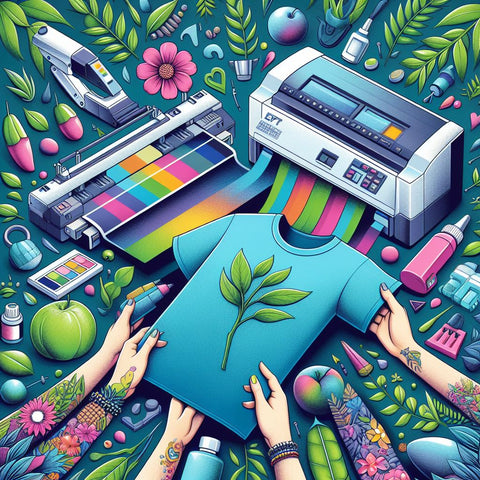Frequently Asked Questions
1. What are DTF transfers?
2. What are the main benefits of using DTF transfers?
3. What equipment is needed for DTF transfer printing?
4. How should one maintain DTF transfer equipment?
5. What tips can help ensure successful DTF transfer printing?
In the ever-evolving world of printing and design, custom dtf transfers have emerged as a revolutionary method, offering unparalleled versatility and ease of use. If you’re looking to enhance your printing capabilities and bring your designs to life like never before, understanding DTF transfers is critical. In this article, we will delve into the basics of DTF transfers, explore their benefits, and how you can make the most of this innovative technology.
What are DTF Transfers?
DTF stands for Direct to Film, a printing technology that allows you to print designs onto a special film, which can then be transferred onto various materials, usually fabrics. This method has gained popularity due to its ability to produce high-quality prints with vibrant colors and a wide range of applications.
The DTF Process Explained
The process of creating custom dtf transfers consists of several steps:
- Design Creation: Start with designing your artwork using graphic design software.
- Printing: The design is printed onto a special film using a DTF printer that utilizes a water-based ink system.
- Powder Adhesive Application: Once printed, an adhesive powder is applied to the film while the ink is still wet.
- Heat Curing: The film with the adhesive is then heated, allowing the powder to bond with the ink.
- Transfer Process: Finally, the design is pressed onto the desired surface using a heat press, resulting in vibrant and durable prints.
Why Choose DTF Transfers?
With numerous printing methods available, you might wonder what makes custom dtf transfers stand out. Here are some compelling reasons to consider this innovative technique:
Versatility in Material Use
DTF transfers can be applied to a variety of materials, including cotton, polyester, and blended fabrics. This versatility opens doors for numerous applications, from apparel to accessories, making it ideal for businesses that require custom printed merchandise.
High-Quality Prints
When investing in printing, quality is paramount. DTF transfers produce exceptional color vibrancy and detail, making your designs pop. This is especially important for businesses aiming to create eye-catching products that stand out in a competitive marketplace.
Ease of Use
The DTF transfer process is straightforward and does not require extensive training. Once you have the right equipment and materials, you can quickly produce custom dtf transfers with minimal hassle. This ease of use is perfect for both small businesses and larger operations looking to scale up their production.
Common Applications of DTF Transfers
The versatility of DTF transfers allows for a plethora of applications across various industries. Here are some common uses:
- Fashion Apparel: T-shirts, hoodies, and other clothing items featuring unique designs.
- Promotional Merchandise: Custom apparel for events, giveaways, or branding purposes.
- Home Decor: Custom designs on throw pillows, wall hangings, and more.
- Accessories: Personalizing items like tote bags, caps, and aprons.
Understanding the Equipment Needed
To get started with custom dtf transfers, you'll need to invest in some essential equipment. Here’s a breakdown of what you'll typically need:
DTF Printer
A DTF printer is the heart of the operation. These printers are equipped to handle the water-based inks used in the DTF process. They come in various sizes and functionalities, so choose one that aligns with your production needs.
Heat Press
A quality heat press is essential for properly transferring the designs onto fabrics. This equipment ensures consistent temperature and pressure, which are crucial for achieving the best results.
Transfer Film
You’ll require special transfer film designed for DTF printing. This film is critical for printing your designs, as standard paper cannot produce the same quality.
Adhesive Powder
Adhesive powder is another vital component, allowing for the adhesion of the ink to the material during the transfer process. It is typically available in various formulas specific to the types of fabrics you’ll be using.
Maintenance and Care for DTF Transfer Equipment
To get the most out of your DTF transfer setup, proper maintenance is key. Here are some tips to keep your equipment in top shape:
- Regular Cleaning: Clean your printer and heat press regularly to prevent clogs and ensure optimal performance.
- Proper Storage: Store your transfer film and adhesive powder in a cool, dry place to maintain their effectiveness.
- Training: Ensure that all team members are trained on how to use the equipment properly to minimize accidents and mistakes.
Finding the Right Supplier
When it comes to custom dtf transfers, sourcing quality materials is essential. Working with a reliable supplier can make a significant difference in the quality of your final products. Here are some tips for selecting the right supplier:
Quality Assurance
Always check for reviews and testimonials from other customers to ensure that the supplier offers high-quality products. Quality materials will lead to better printing results and increased customer satisfaction.
Product Variety
Choose a supplier that offers a wide range of products, including different types of transfer films, inks, and adhesive powders. This variety allows you to experiment and expand your capabilities.
Customer Support
Having access to excellent customer support can be invaluable, especially when you're facing challenges with your equipment or materials. Look for suppliers that offer responsive and knowledgeable support to help you navigate any issues you encounter.
Tips for Successful DTF Transfer Printing
To help you navigate your new DTF printing journey, here are some tried-and-true tips for success:
- Artwork Preparation: Ensure your designs are high-resolution and properly formatted for printing.
- Testing: Conduct test prints before full-scale production to adjust settings and get accustomed to the equipment.
- Temperature and Time Settings: Pay close attention to the heat press settings for each material to ensure optimal transfers.
- Experiment: Don’t hesitate to experiment with different materials and designs until you find your ideal results.
Transform Your Business with DTF Transfers
As you venture into the world of custom dtf transfers, remember that this printing method holds the key to unlocking a new level of creativity and commercial opportunities. By embracing DTF technology, you can offer your customers unique and high-quality products that stand out in today’s competitive market.
Investing in DTF transfers allows for a seamless blending of artistry and functionality, enabling businesses to grow and evolve alongside the demands of the modern marketplace. With quality materials, the right equipment, and a commitment to excellence, your printing business can thrive and make a lasting impact.
So, why not take the plunge into the vibrant world of custom dtf transfers today? Your artistic vision deserves to shine, and with DTF technology, it can!





Comments (0)
There are no comments for this article. Be the first one to leave a message!